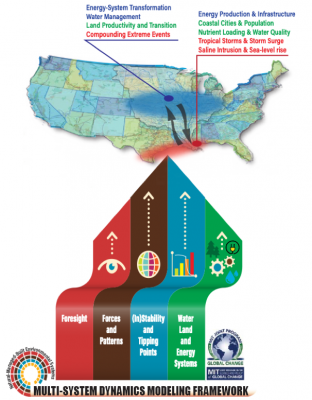Sectoral Interactions, Compounding Influences and Stressors, and Compound Systems: Understanding Tipping Points and Non-Linear Dynamics
Project Team
Principal Investigator
Co-Principal Investigator
For more than 25 years, the Massachusetts Institute of Technology (MIT) Joint Program on the Science and Policy of Global Change has focused on a balanced approach for continual development and numerical experimentation within a multi-system, multi-sectoral modeling framework, and analysis system.
The Cooperative Agreement, "An Integrated Framework for Modeling Multi-System Dynamics," is focused on:
- Continuing development of our integrated global modeling system (IGSM), with a focus on energy-water-land-atmosphere interactions;
- Better characterization of uncertain responses of the Earth system at scales relevant to decision-making under uncertainty; and
- Focused efforts on the interactions within the U.S. to develop a better understanding of vulnerability to global environmental change and tools that can assist in adaptation to these changes.
Within and consistent with the scope of the Cooperative Agreement, the research team will strengthen understanding of how primary interactions among water, land and energy systems and corresponding development may both influence, and be influenced by, economic activity at regional and sub-regional scales (or, more generally at multiple scales). Emphasis will be on long-term changes in stressors and influences (the latter can be positive or negative), concentrating on weather patterns and extremes, population/demographic shifts, and existing infrastructure and its future reconfiguration within a range of typological landscapes, from urban to rural and accompanying gradients. Specifically, the general objectives of this work are to examine the following major science questions:
- Forces and Patterns. What combination of factors, varying by geography, contribute to salient patterns of economic and infrastructure development in trans-regional, regional, and sub-regional evolutions, including interactions and interdependencies among natural and built environments and human processes and systems?
- Stabilities and Instabilities. What characteristics of interacting natural and built environments and human processes lead to stabilities, instabilities, and tipping points in economic and infrastructure development across systems, sectors, and scales, and what role do strong interdependencies, feedbacks, influences, and stressors play?
- Foresight. How might long-term economic and infrastructure development patterns, stabilities, instabilities and systems resilience evolve within multi-sector, multi-scale landscapes as a result of future forces, stressors and disturbances (natural and as a result of human activity), and what pathways, characteristics, and risk profiles may emerge from both gradual and abrupt transitions?


